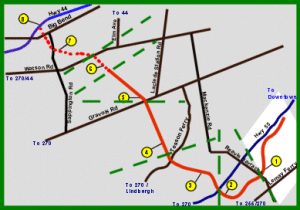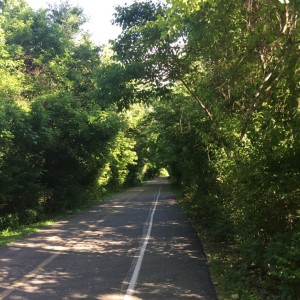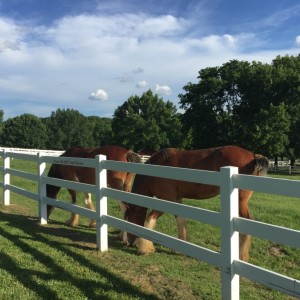A Sunday afternoon in late May: I’m biking Grant’s Trail in suburban St. Louis, roughly 17 miles of an asphalt trail that at one time was a railroad track. Add the mile-and-a-half from my house to the trailhead, and I have a relatively flat 20 miles round trip.
I’ve been biking this trail since 2005, when it was three miles shorter, and a rather bumpy ride over old railroad bed gravel. My first ride over the pre-asphalt section led me to the discovery of the unexpected hole. Fortunately for my dignity, no one was nearby to witness the aging cyclist hit the hole, fly up from his bicycle seat, and spend the next few seconds (eternity in the moment) struggling to stay upright. I managed it. Barely.

Grant’s Trail in south suburban St. Louis
But the unpaved became the paved, the hole was filled in and covered over, and the ride became less eventful.
Until the day of the snake. The black snake. The big black snake. The big Missouri black rat snake. Did I mention it was BIG?
I was on the return portion of the trail, and had just ridden under Interstate 55. I came up to a crowd of walkers, joggers and bikers who were standing on the trail in complete silence. I looked.
The trail is eight feet wide, four feet for each lane. Stretching across six of the eight feet was a Missouri black rat snake. I had seen larger snakes at the St. Louis Zoo. I had never seen one this big in the wild. It was moving, slowly, from one stretch of wooded brush to a more heavily wooded area. Grant’s Trail traverses several county parks, the Grant’s Farm Children’s Zoo (and Free Beer Tent), the Ulysses S. Grant home of Whitehaven, and some fairly wooded areas that have yet to fall to the developer’s ax.
It was one of these where Mr. Big Black Snake was traversing. He (or she) finally went on its way, and so did the rest of us.
I’ve come across smaller black snakes on the trail, and a few other kinds I did not stop to inspect, but none as spectacular as that big one.

The wildlife-laden section of Grant’s Trail, home to deer, turkeys, and snakes.
Snakes notwithstanding, one section of Grant’s Trail is the most wildlife-saturated. The eastern side, near where it ends alongside Interstate 55, is home to all kinds of animals. I once passed a family of wild turkeys—two adults and eight chicks—strolling alongside the trail and not bothered in the least by helmeted-aliens wearing Lycra tights and rolling by on two wheels.
The deer can be a problem, however. They will suddenly dart from the woods. One time a doe nearby broadsided me. Hitting a deer with your car can smash the car’s front end; hitting a deer with your bike will smash the bike—and the cyclist. Another time it wasn’t just a doe—it was an entire herd that decided to dart suddenly, right in front of me.
My brakes worked. They also worked with the suicide squirrel, who decided we were in a race and kept throwing himself at the spokes of my front wheel.
One of the most incredible experiences I’ve had on area trails wasn’t on Grant’s Trail, but on the Katy Trail, which stretches 264 miles from just north of St. Louis to Clinton, Missouri, about two-thirds of it along the Missouri River.
I was riding from St. Charles in suburban St. Louis to Augusta (Missouri wine country), and I heard a “whoosh” just to my right. I looked; an American bald eagle was flying alongside. Our togetherness continued for about two minutes (another one of those eternities in the moment). I was wondering if he considered me lunch, or at least worthy of lunch (they are raptors, after all, but I’ve never heard of a bald eagle attacking a human).
Then, he soared upward and over me, flying toward the river.
Everything they say about the bald eagle is true. Majestic. Beautiful. Awe-inspiring. Powerful. I just never expected to be able to be close enough to almost touch one. And on my bike.

Two Clydesdale horses in a pasture adjacent to Grant’s Trail
Two weeks ago, I was on Grant’s Trail, stopped at a traffic light for one of the major thoroughfares the trail crosses. A man, one of several adults shepherding a group of young children, asked me why I biked. “I’m seeing all kinds of people on bikes around here, ” he said. “Why do you do it?”
My automatic response was “the exercise, ” and he nodded but looked unconvinced.
“No, ” I said, “it’s more than that. It’s the joy, that joy that comes from the surge that happens right when you think your legs will give out.”
He grinned. “Like the second wind in basketball, ” he replied. “That I understand. I got it.”
But it’s more. It’s the joy of encountering the unexpected, like the big snake. It’s the creation of stories that come from doing the out-of-daily-routine. It’s the joy of seeing the Clydesdales horses at Grant’s Farm, running through the early morning mist. It’s the joy of being accompanied by an eagle, and the two of you are the only living things in sight.
It’s the poetry, the natural poetry, of the biking trail.
Photo by OmerUnlu, Creative Commons, via Flickr. Post by Glynn Young, author of the novels Dancing Priest and A Light Shining, and Poetry at Work.
__________________________

“I require all our incoming poetry students—in the MFA I direct—to buy and read this book.”
—Jeanetta Calhoun Mish
- Poets and Poems: Rosemerry Wahtola Trommer and “The Unfolding” - November 21, 2024
- Poets and Poems: Catherine Abbey Hodges and “Empty Me Full” - November 19, 2024
- “The Colour Out of Space” by H.P. Lovecraft and Sara Barkat - November 14, 2024

Jerry says
Keep riding the poetry Glynn!
Glynn says
As the poet Popeye would say, Iamb who Iamb. Thanks for reading, Jerry!
Martha Orlando says
Suicide squirrel . . . Lol!
I know you see poetry in everything – what a gift, Glynn! Ride on!
Glynn says
Well, I have to say I didn’t see a lot of poetry in the 6-foot snake. All I kept thinking was “I hope I bike faster than it crawls.) And this past Sunday, what did I almost bike across but a two-foot version of that big snake!
Thanks for the comment, Martha.
Laura (L.L.) Barkat says
I love the humor in this piece 🙂
• Until the day of the snake. The black snake. The big black snake. The big Missouri black rat snake. Did I mention it was BIG?
• I once passed a family of wild turkeys—two adults and eight chicks—strolling alongside the trail and not bothered in the least by helmeted-aliens wearing Lycra tights and rolling by on two wheels.
And of course the eagle is nothing short of fantastical 🙂
Glynn says
The eagle posed a conundrum. I desperately wanted to pull my phone out and snap a picture, but I knew that as soon as I broke pace the eagle would likely take off. And I wasn’t sure if I was traveling companion or lunch possibility. But it was one of the most memorable experiences I’ve had with nature – biking and otherwise.
Bethany R. says
Okay, I love this piece.
I’m with Laura on the humor (I’m always looking for sparks of it in my reading and my life). “The suicide squirrel,” to be sure, and “the unexpected hole,” both struck me funny.
But I also love what this opens up: finding the natural poetry in our gardening, farmers’ market strolls and ferry rides.
Can I make a wish? A series of “The Natural Poetry of_____” 🙂
Thanks for writing this, Glynn, and for publishing it, Tweetspeak Poetry. Such a fun community here.
Glynn says
Bethany – thanks for reading and the comment.
Megan Willome says
Preach it, Brother Glynn!
I do think it’s “the joy of encountering the unexpected.” That’s why I always tweet out my wildlife encounters. Deer are always an issue where I ride, as are the buzzards that swoop down to feast on the ones taken out by pickup trucks. Depending on the route, I cross ranches, so I know to watch out for sheep on Cherry Mountain, cattle on Lower Crabapple. John saw a snake on the Willow City loop.
Also I like the unexpected surprises of, “Oh, look–there’s a creek where there’s never been a creek before” after a big rain. I love seeing the wildflowers change and the trees. I’ve seen bridges go up, houses come down. And of course, helmeted tourists in Lycra.